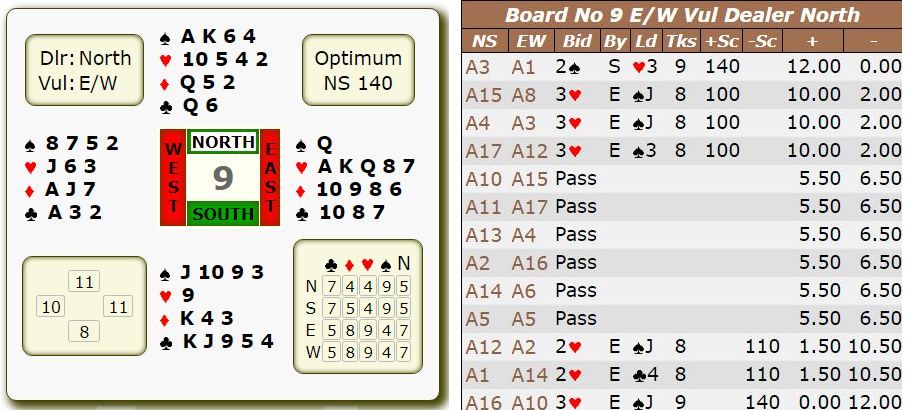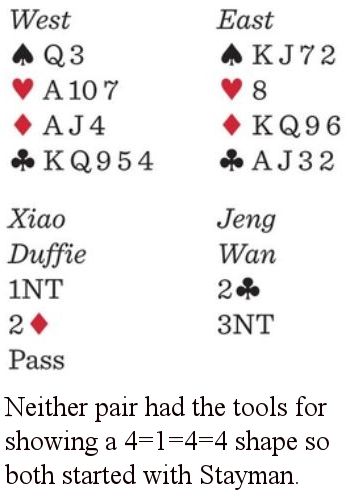Weak Notrump Opening
Virtually every decent bridge player plays Weak-Two (of a suit) opening bids. Opening 2 of a suit with 6-12 HCPs and a 6-card suit accurately describes your hand for partner while taking a lot of bidding space away from your opponents.. For some reason, the vast majority of people who play Weak Two bids do not play Weak Notrump bids despite the fact that they have the exact same advantages. The ACBL says on their web site:
Experienced players find the 15-17 point range preferable for several reasons. 1NT is the most descriptive one-level opening bid, so we like to use it whenever our hand meets the requirements. You get more 15-point hands than you do 18-point hands, so the lower range allows you to open 1NT more frequently. A 1NT opening also makes it more difficult for the opponents to interfere. If you open 1?, the opponents can easily come in with an overcall on the one level. When you open 1NT, they have to risk a two-level overcall. Everything the ACBL says about the advantages of the 15-17 range for opening 1N applies evem more so to lower ranges. The average number of HCPs a player gets over the course of an event is 10 (40 total HCPs in the deck divided by 4). The HCP points required when playing 15-17 NT is 50%-70% higher than the average points of 10 while with a range of 10-12, the HCPs required are 0% to 20% higher. Not only that, but when playing 15-17, if you have 10-12 points and a balanced hand, you usually won't be able to open; you'll have to pass, while playing 10-12 HCPs, you can open 1N, conveying much information to partner while obstructing the opponents. Finally, Larry Cohen says on his web site that preempts should be lighter (fewer points) in first chair since you have two opponents to obstruct and only 1 partner (who you're actually helping by describing your hand). Cohen is referring to 3-level and higher preempts, but the same applies to a 10-12 or 11-13 one notrump which also has preemptive value. There is some debate about whether or not to play transfers in WNT. The usual argument for transfers in strong NTs is that it lets the stronger hand be declarer. This is not as significant in WNTs where responder could easily have at least as many points, or even more, than opener. Another benefit of not playing transfers is that it leaves 2 The famous Kaplan-Sheinwold system which many later players have adopted and adapted uses weak notrumps and did not use transfers. Bids by responder: 2 2
 with a 5-card minor, else 2N. with a 5-card minor, else 2N.2 2N is invitational. 3 Options: Jacoby Transfers, though this allows opponents to make lead-directing doubles.. Puppet Stayman asks partner for a 4-card OR 5-card suit. Also see Notrump Bidding. Examples:
Playing a Weak NT (10-12 or 11-13 HCP), North could open 1N. If East overcalls 2
The Optimum was 6 In this case, not opening 1N was about the only way to reach the Optimum:
 -1 -1
1N(15-17)-3 
3N-4  , ,
4N-... etc. East has other options besides 3 But the point is that where 1N dead-ends at 3N, a Weak NT gives more room to explore when holding a hand like West's.
|
 available for game-forcing Stayman.
available for game-forcing Stayman.
 and 3
and 3 can be used as forcing in reponse to 1NT. Opener raises with 3+ of the suit and otherwise bids 3NT.
can be used as forcing in reponse to 1NT. Opener raises with 3+ of the suit and otherwise bids 3NT.

 , South can double and if East passes, South can bid Stayman. Either way, NS get into the bidding.
, South can double and if East passes, South can bid Stayman. Either way, NS get into the bidding.
 From the May 2020 Bridge Bulletin, page 34, Problem 4:
From the May 2020 Bridge Bulletin, page 34, Problem 4: